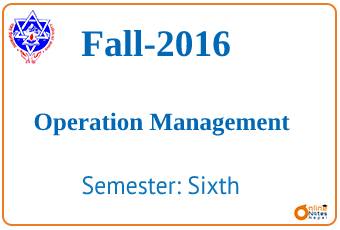Published by: sadikshya
Published date: 27 Jun 2021

This is the question set along with answers of Fundamentals of Operations Management Fall 2016, which was taken by the Pokhara University.
Pokhara University –Fundamentals of Operations Management Fall 2016
| Level: Bachelor | Semester –Fall | Year: 2016 |
| Program: BCIS\BBA | Full Marks: 100 | |
| Course: Fundamentals of Operations Management | Pass Marks: 45 | |
| Time: 3hrs. | ||
Section “A”
Very Short Answer Questions
Attempt all the questions.
1. Explain the concept of operations management.
2. Explain the concept of JIT Production system.
3. What is ERP?
4. What do you mean by Job shop technology?
5. What do you mean by robust design?
6. What do you mean by competitive advantage?
7. Define TQM.
8. Write about bullwhip effect.
9. What is Kanban?
10. What is service blue printing?
Section “B”
Descriptive Answer Questions
Attempt any six questions
11. Define operation system. Explain the most recent trends of operation management in Nepal.
12. Six Jobs are to be processed through a two steps operation. The first operation involves sanding and the second involves painting. Processing times in days are as follows:
Job Sanding (days) Painting (days)
PICTURE
Apply Johnson’s rule and calculate
(i) optimal schedule (ii) total completion time(days).
13. Construct the mean and range charts for the following data in which samples of 4 being taken every hour. Comment on your result whether the production seems to be under the control or not, assuming that the data are given below:
PICTURE
From the table n=4,A2=0.729,D3=0,D4=2.282
14. Explain the supply chain management. Also explain stages of vendor selection process.
15. The Annapurna Hotel in the preceding example uses approximately 600 base of soap each day and this tends to be fairly constant. Lead time for soap delivery is normally distributed with a mean of six days and standard deviation of two days. If a service level of 90% is desired. Find the ROP.
16. What factors you will be considered before choosing the best capacity decisions?
18. Section “C”
Case Analysis
Read the following case below and answer the questions that follow:
Maruti Suzuki Limited is one of the most successful examples of supply chain management in the Indian automobile sector. Over the years it has worked to convert many obstacles into opportunities. Maruti has around 246 local suppliers and about 20 global suppliers. They all function in a seamless manner. The company strictly receives its supplies, ordered the previous night, in a two-three hour slot the next day than an initial 30-days supply period. Some of the salient features that make the supply chain of Maruti effective are summarized below. Maruti was set up in the 1980s. Many of the Suzuki’s global vendors set up joint ventures in the northern region of India. While setting up the plant, the government had approved of manufacturing only on condition of localization of components. Maruti used this by scouting for entrepreneurs and turning them into vendors, facilitating loans, licenses, technical know-how and even location in a phased manner. Of the 246 suppliers, Maruti has joint ventures with 14 of them and hold strategic equity stake to have a say in production and quality issues.
Maruti, however, was not satisfied with the delays in production due to the time lag in supplies. The company had adopted the Japanese system, just-in-time to achieve higher operational efficiencies and reduce inventory carrying cost. Maruti Suzuki has adopted the e-Nagare system of electronic flow which has completely transformed its supply chain. To achieve JIT material supplies, the company has given preference to locally based suppliers. Over 76 percent of the company’s 246 suppliers are located within the radius of 100km. They have strategically located the suppliers of bulky components such as instrument panels, fuel tanks, bumpers, seats, etc. adjacent to the company’s manufacturing facilities in the Supplier’s Park.
Maruti supports its vendors in all possible ways. This includes finding technology partners, giving financial, technical and management support and bringing transparency in its dealings. Of late, Maruti has been collaborating with its suppliers to smoothen human resource development issues which had resulted in strikes and delays. Fifty-four of the top 80 component suppliers of Maruti Suzuki India compete against each other in what has been called ‘Quality Circle Competition’ and the top three get a chance to present their cases in Suzuki’s Japan facility alongside other global vendors. The idea behind the QCC was for the teams from different vendors to identify, discuss and resolve any one core business issue that will add value to the overall functioning of the company, thereby increasing overall efficiency.
Questions:
i) Maruti has joint ventures with 14 suppliers, what kinds of supply chain strategies it is? Explain different others kinds of supply chain strategies too.
ii) Has the implementation of quality circle affected the efficiency and responsiveness of supply chain of Maruti Suzuki India?
iii) Do you think JIT technique used by Maruti contributes to competitive advantages?
iv) You must suggest how Maruti Suzuki builds the lean management system for better performance.